Fluffy Scrambled Eggs (Step by Step!)
This is the BEST recipe for extra soft and fluffy scrambled eggs. Learn which secret ingredients are used to make them extra creamy (without milk), and what you can add to kick up the taste even more!
PRO tip: Serve these inside warm Breakfast Tacos! And try my Homemade Pancakes next!
There are a lot of recipes that come out of my kitchen on a weekly basis, but nothing seems to make me quite as proud as when I whip up a batch of fluffy scrambled eggs.
They say that if you can properly make eggs, you can make anything. Probably because there is a certain technique involved for eggs to come out just right.
I’ve had people report back to me on Instagram about this recipe, and the words “life changing” were used more than once. So I’m excited for you to try this. Let’s get to it!
How To Make Scrambled Eggs (Step by Step)
Crack the eggs into a small bowl and whisk vigorously for 1 minute. If you’re adding cheese, whisk the cheese in as well.
Melt the butter over LOW heat in a nonstick skillet and wait until it begins to foam.
Remove the pan from the heat and add the eggs. Return the pan to the heat.
Whisk the top of the eggs vigorously again until the top is very foamy. Try not to touch down on the bottom of the pan.
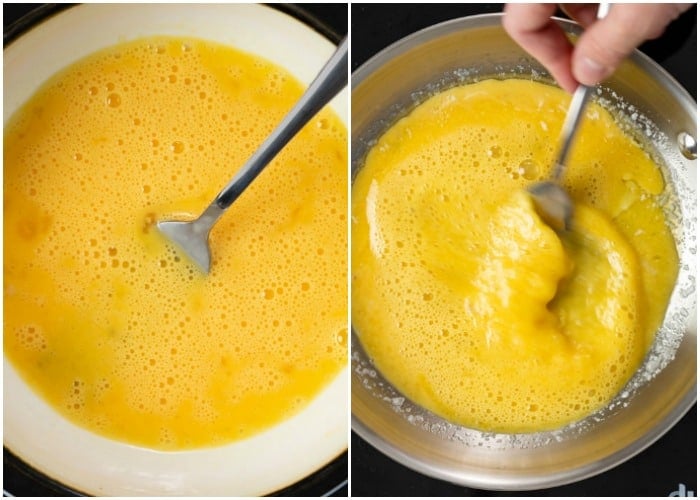
Let the bottom of the eggs set for 5-7 seconds. Run a silicone spatula from the edge of the pan into the middle.
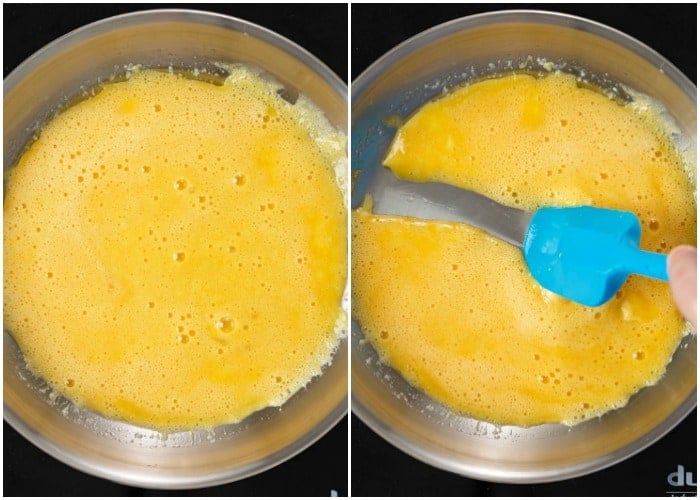
Tilt the pan so that the uncooked eggs can slide onto the surface area that you just created with the spatula.
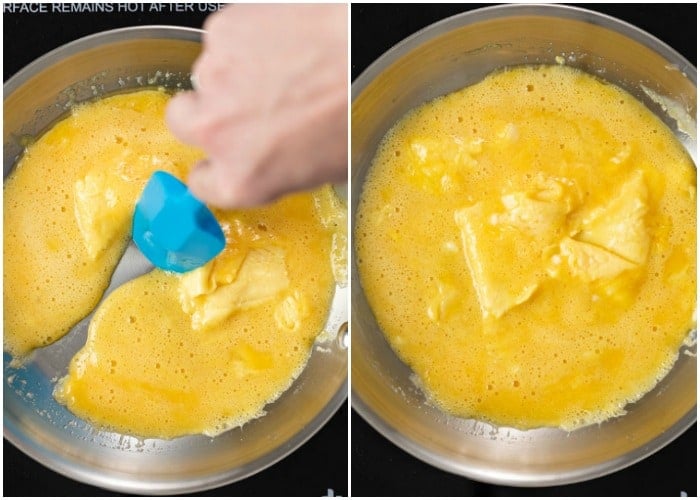
Continue to slide the cooked eggs into the middle with the spatula and rotate to allow uncooked eggs to hit the surface pan.
After about 30 seconds or so, the eggs will be mostly set. Remove them from the heat. The heat from the pan will finish cooking them. Gently fold the eggs so that any remaining wet spots touch the pan and finish setting.
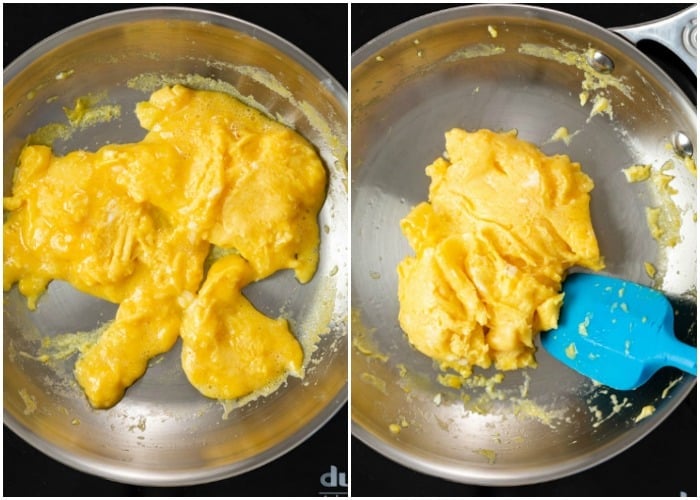
If desired, create ‘slices’ with the spatula to create smaller bites that will resemble a scramble.
Season with salt/pepper and transfer to a serving plate. Serve with skillet potatoes if desired.
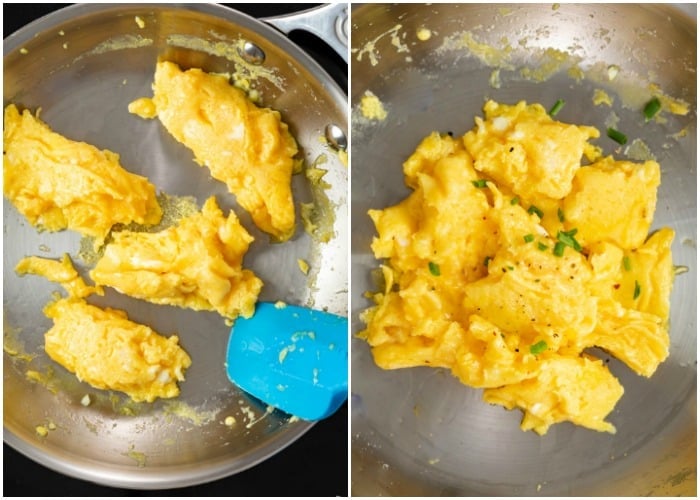
Do You Add Milk to Scrambled Eggs?
- Adding milk to scrambled eggs waters them down and dilutes the taste. This practice originated as a means of stretching the eggs out further so you could serve more using fewer eggs.
- For a creamier consistency, you can add about 1/2 Tablespoon of heavy cream, sour cream, or cream cheese per egg.
Use the Right Size Skillet
- Using the right size skillet is crucial for evenly cooked scrambled eggs. A 7-inch skillet is perfect for making 2 scrambled eggs, (the amount I recommend making per person).
- I swear by this 7-inch Cuisinart Nonstick Skillet!
Wait Until the Butter Foams
- For best results, let the butter warm up over LOW heat until it foams before you add the eggs. If the butter is just melted, the eggs will absorb it instead of cook in it.
- Foaming also means that some of the water is evaporating out of the butter, which is ideal.
- Some people use oil or a combination of oil and butter. I like to just use butter. If you use oil, add the eggs when the oil begins to shimmer.
Whisking = EXTRA FLUFFY and Light!
- Whisk the eggs vigorously before you add them to the pan and even once they’re in the pan. The eggs should be foamy on the top. Foam = air pockets, which is the key to a fluffy consistency.
- Use a fork to whisk as this gives you more control, especially when whisking in the pan itself. You don’t want to scratch the bottom of the pan when whisking, keep it on the surface.
Remove the Pan From the Heat When You Add the Eggs
- This gives you more control over the heat and allows the eggs to come to temperature slowly and more evenly.
Cook Slowly Over LOW Heat
- Cooking over low heat allows the eggs to cook at an even rate and keeps them soft. Cooking them for too long or over higher heat will cause them to become hard.
Adding Cheese
- If you plan on adding cheese, let the cheese come to room temperature. Adding cold cheese will cause the eggs to cook unevenly.
- Shred the cheese from a block for creamiest consistency. Bagged cheeses contain cellulose which prevents it from melting as well.
- Use creamy cheeses such as Muenster, Provolone, American, Cheddar, Mozzarella, Gouda, Gruyere, Goat Cheese, Monterey Jack.
- Cracker Barrel Yellow Cheddar is my go-to cheese. It tastes great and melts really well.
Handle the Eggs Minimally
- As the eggs cook, run a silicone spatula from the edge of the pan right into the middle. Rotate the pan so that the uncooked eggs slide onto the surface that you just created with the spatula. Repeat this technique as the eggs begin to set.
- Handling them minimally and gently keeps the air pockets intact that were created from whisking, which maintains their fluffy texture.
Don’t Add Salt Until the End
- Once salt is added to food, it begins to extract moisture. For this reason, you want to wait until the end to season your eggs with salt and pepper to ensure that the eggs don’t become watery.
What Can You Put in Scrambled Eggs to Make Them Taste Better
Sauces:
Add a little sauce to your eggs to add more flavor. Be sure to add it when you’re whisking to incorporate it evenly into the eggs.
- Options include Tabasco, Hot Sauce, Worcestershire Sauce, Soy Sauce.
- Salsa is another popular choice but can be watery, so think about serving it on the side.
Vegetables:
- Chives, Green Onions, Shallots, Spinach, Mushrooms, and Peppers are all great choices.
Meat/Seafood
- Bacon, Ham, and Sausage make great additions to scrambled eggs.
- Smoked Salmon, Lobster, Crab, and Shrimp are also delicious.
How Many Eggs Per Person for Scrambled Eggs
- 2 eggs per person is a good rule of thumb for scrambled eggs.
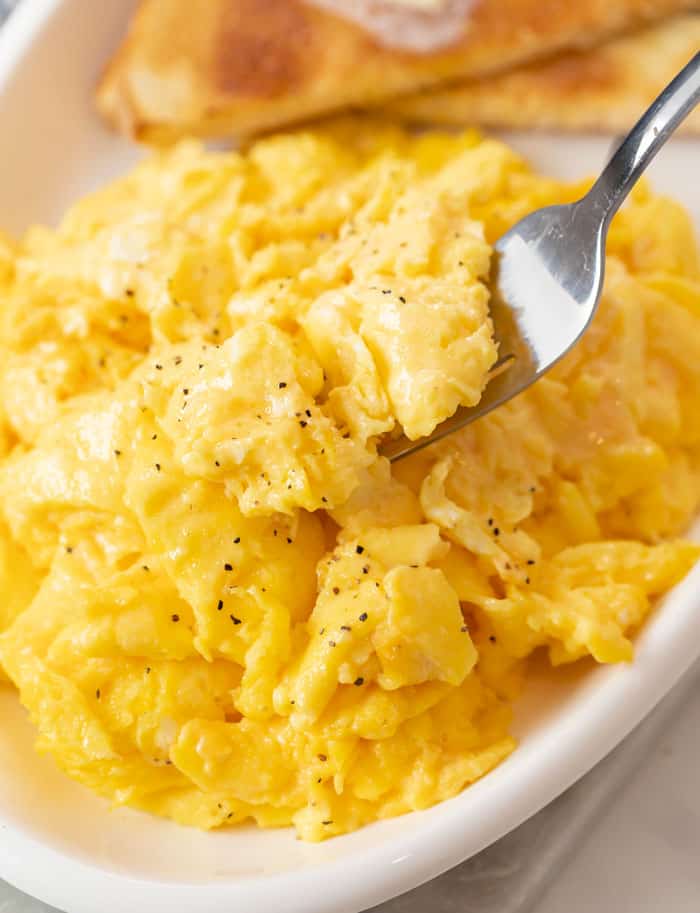
What to Serve with Scrambled Eggs
- Serve them in Breakfast Tacos!
- Sausage Gravy and Buttermilk Biscuits
- Skillet Potatoes
- Hashbrown Casserole
- Cheddar Bay Biscuits
- Waffle Iron Hash Browns
👉Be sure to try my Hashbrown Breakfast Casserole and Egg Muffin recipes next!
Tools For This Recipe
(Amazon affiliate links)- Check out all of my kitchen essentials here.
- 7-inch Cuisinart Nonstick Skillet– This is the kind that I use and is the perfect size for making 2 scrambled eggs. An 8-inch skillet will work as well.
- Silicone Spatula. This is the best way to handle the eggs gently enough to preserve the air pockets, which keeps them fluffy!
- White Serving Platters– The small one here is what I use for serving up a nice breakfast platter of eggs, toast, and sausage/bacon.
Get My Free E-Book!
- I’ve got a FREE e-Book with 7 super popular dinner recipes! Click here to join my email list and I’ll send your e-Book right over!
- And be sure to follow me on Instagram, Pinterest, & Facebook!
Tried This Recipe?
Leave a review, I love hearing your feedback! ⭐⭐⭐⭐⭐
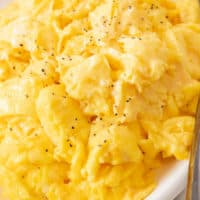
Fluffy Scrambled Eggs
Ingredients
- 2 large eggs
- 2 Tablespoons salted butter
- ¼ cup cheddar cheese, shredded
- Chives, to garnish (optional)
Equipment
Instructions
- Crack the eggs into a small bowl and whisk vigorously for 1 minute.
- Melt the butter over LOW heat in an 7-inch nonstick skillet. Wait until it begins to foam.
- Remove the pan from the heat and add the eggs.
- Whisk the top of the eggs vigorously again, try not to touch down on the bottom of the pan.
- Return the pan to the heat. Continue to whisk the eggs until the top is very foamy. Sprinkle the cheese on top and whisk to incorporate.
- Let the bottom of the eggs set for 5-7 seconds. Run a silicone spatula from the edge of the pan into the middle. Tilt the pan so that the uncooked eggs can slide onto the surface area that you just created with the spatula.
- Continue to slide the cooked eggs into the middle with the spatula and rotate to allow uncooked eggs to hit the surface pan.
- After about 30 seconds or so, the eggs will be mostly set. Remove them from the heat. The heat from the pan will finish cooking them. Gently fold the eggs so that any remaining wet spots touch the pan and finish setting.
- Create 'slices' with the spatula to create smaller bites that will resemble a scramble.
- Season with salt/pepper (and chives if desired), and transfer to a serving plate. Serve immediately!
Notes
- About 1/2 Tablespoon of heavy cream, sour cream, or cream cheese may be added when the eggs are added to the pan.
- Try serving these in Breakfast Tacos, and try my Egg Muffins and Homemade Pancakes next!
Tools For This Recipe
(Amazon Affiliate)- 7-inch Cuisinart Nonstick Skillet- This is the kind that I use and is the perfect size for making 2 scrambled eggs. An 8-inch skillet will work as well.
- Silicone Spatula. This is the best way to handle the eggs gently enough to preserve the air pockets, which keeps them fluffy!
- White Serving Platters- The small one here is what I use for serving up a nice breakfast platter of eggs, toast, and sausage/bacon.


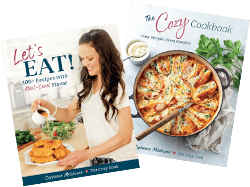 Get my Cookbooks!
Get my Cookbooks! 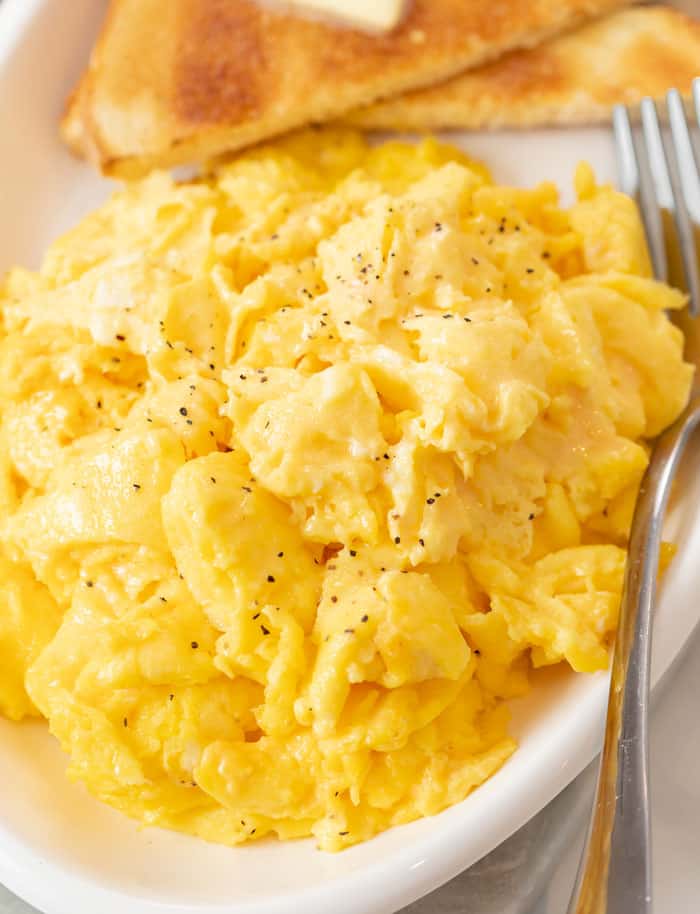
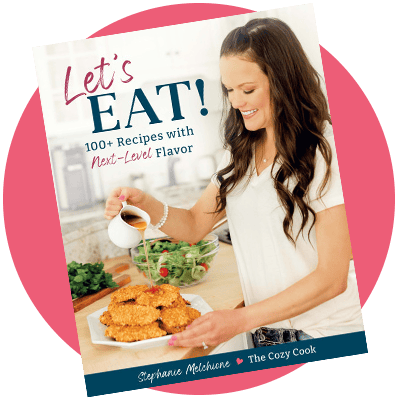
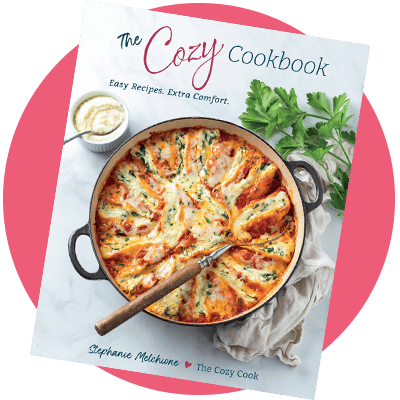
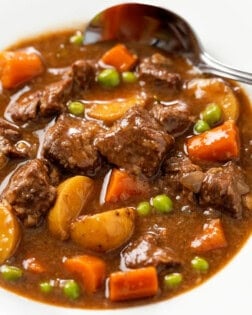
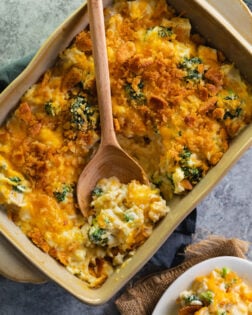
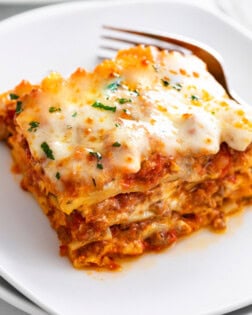
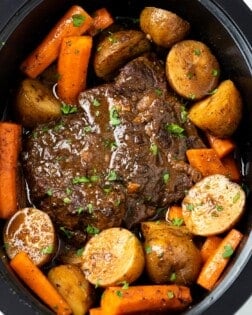

The air you mentioned while beating is a big no-no. The air bubbles acts as an insulator which means the heat cannot move through the eggs quickly enough causing tougher eggs.
The cream you mentioned is the French style of cooking eggs which makes them more dense and less fluffy.
For every two eggs used, add one egg yolk. If you want a brighter yellow batter, add a pinch of salt and let the egg batter rest.
Use high heat. The residual water from the egg will steam as you move them around in the hot pan. This steam will cause the eggs to double and triple in size. Be patient with the steam process but be careful not to over cook. Takes a little practice but will be a master in no time!
I’m sure the way that you prepare your eggs is wonderful, and thank you for sharing! But air pockets do create a fluffy egg. The pockets expand when heated, which is what gives the eggs a lighter, fluffier texture. Lower heat is also crucial so that the air bubbles don’t collapse, which causes the eggs to be dense. There are many delicious ways to prepare scrambled eggs and I don’t doubt that your method is one of them. But the tips that I outline here aren’t incorrect.
These are good! I think the no salt while cooking was key
I’m so happy it was such a success Ann! My daughter is super picky when it comes to scrambled eggs and this is the only way she eats them. Thanks so much for the review!!🩷
What an incredible recipe.! Thanks
AWESOME! I’m so happy to hear that Kurt, thank you so much!!